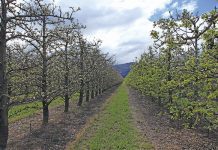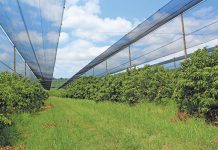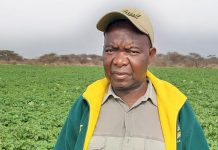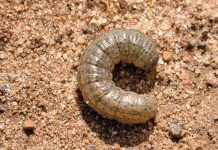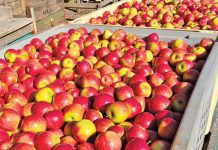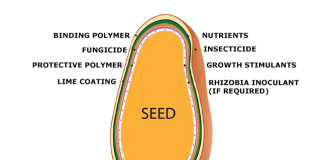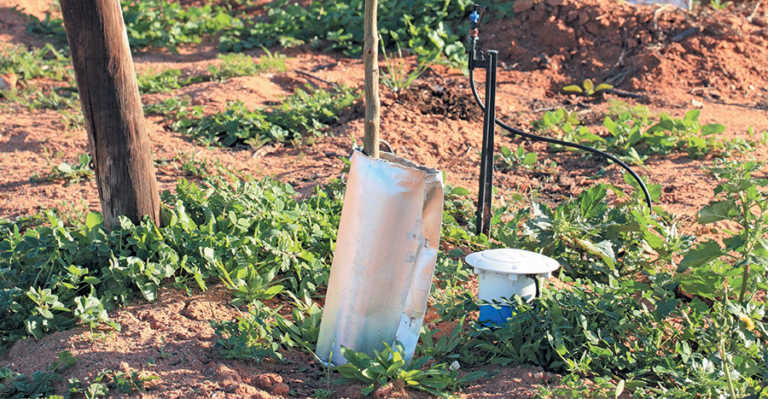
Innovative Robertson farmer, Louis Loubser, is an avid inventor who has devised a number of implements to improve production efficiency since he started farming almost 10 years ago. His latest invention focuses on cutting water and energy use in orchards.
These include a device with movable excavators that can dig up to 1 360 planting holes per hour, and a pole planter that allows workers to do the job in less than a quarter of the time it normally takes.
However, it is his latest invention, the Tree Hog, that has caused the most stir in the industry as it is responsible for significantly cutting water and energy use in orchards. “I feel as if I am in a daze,” he says.
“Major retailers are phoning me from overseas to become part of the commercialisation of the project. They’re calling it the ‘irrigation breakthrough of the decade’ because it enhances irrigation efficiency – it reduces the water and energy footprint of a farm.”
A need for cutting water and energy use in orchards
Louis came up with the idea of cutting water and energy use in orchards in December last year, when a wall of an irrigation canal from the Breede River collapsed, leaving him dependent on the limited water supply on his farm.
“Sitting with a water shortage at a critically important stage of fruit and vineyard production forced me to re-evaluate my water management system,” he recalls.
“It sparked the idea of placing plastic containers over my micro-sprinklers to reduce water evaporation. I reasoned that the containers would have the same impact as a mulch or ground cover, but you wouldn’t have to top them up or replace them every year.”
While the idea came too late to alleviate his current water shortage, Loubser started to experiment with the concept.
“Droughts are a reality that farmers have to face every few years. I thought my invention could help reduce this risk,” he explains.
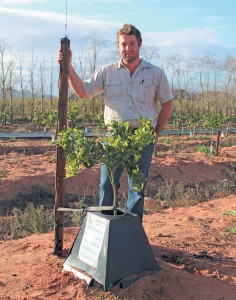
At first, Louis simply used a plastic pot placed upside-down over the micro-sprinkler, making an opening in the bottom for the tree to grow through.
“They were a great start, but the mechanics and angles were all wrong for what I had in mind, and didn’t result in even water distribution. So I started from scratch, using cardboard boxes and bits of plastic sheeting to build my prototype,” he says.
The Tree Hog
Louis describes the Tree Hog as a combination of drip- and micro-irrigation in one product. It concentrates the water from the micro-sprinklers in a small area, creating an intense drip action. Micro-sprinklers tend to waste water because some inevitably lands in the pathways between tree rows.
The Tree Hog ensures that only the area that the farmer wants to irrigate is watered. “At the same time, it disperses water over a wider area than drip-irrigation does, producing trees with better developed root systems. With drip-irrigation, the roots of the trees are often concentrated underneath the drip system,” Louis explains.
Louis has since ironed out some of the design challenges. Instead of using a round pot, he now uses a pot with a rectangular 50cm x 60cm base, covering an area of 3 000cm2 (0,3m2). It is 35cm in height to ensure that it can fit under the first set of a tree’s branches, or the wires in a pruning system.
A micro-sprinkler sprays the water at the optimal angle from the base of the Tree Hog onto the sides of the device, from where it drips down onto the soil, evenly dispersing over the 0,3m2 area.
The Tree Hog has four air vents at its base – one on each side – that can be utilised for aeration and to accommodate the irrigation pipe. The holes can be left open or closed. At the top is a 160mm-diameter opening for the tree trunk. In the final version, this can be enlarged to 260mm as the tree grows.
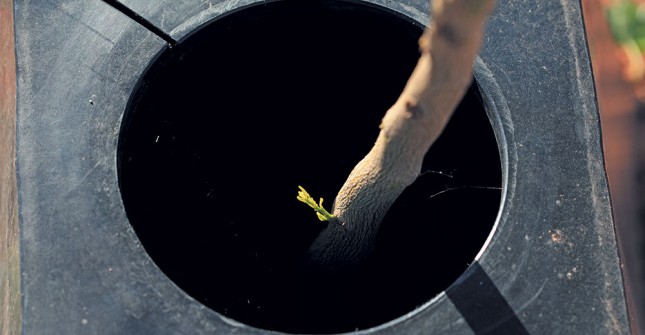
One of the four sides can be opened so that the Tree Hog can be placed more easily over a young tree. It also allows the device to be removed later and re-used.
“The idea is that a farmer would use it mainly on young trees, as a lot of water is lost during irrigation at this stage because of the small tree canopies,” explains Louis.
“Farmers could remove the Tree Hog from the trees when they are about six years old. By then, they have a larger canopy and a well developed-root structure.”
Finding the best material
Louis carried out considerable research on the ideal material to use for the Tree Hog. “I was looking for something durable,” he says.
“Vonnie Heyns, an engineer and the owner of 4EVR Plastic Products, advised me to use ultraviolet-resistant, high-density polyethylene with a thickness of between 1 000 and 1 200 microns. We also used a rib structure to add strength and improve pliability.
“Vonnie has a lot of experience in the plastics industry, and he saw what I wanted to achieve with this product. He guided me on getting the right tools for its development, and also offered to help with logistics and quality control.”
Farm trials
Louis asked one of his neighbours, Lieb Swiegers of the farm La Colline, to evaluate the Tree Hog on a young citrus orchard on his farm. Tree Hogs were placed on a row of trees just after planting.
The performance of the trees and the water-use efficiency of the system was then compared with a control row of young citrus trees watered conventionally. The sprinklers delivered water at 32l/h.
According to Lieb, the Tree Hog greatly improved the water-use efficiency of the micro-sprinkler system.
“We found that we could supply the covered trees with significantly less water and at longer intervals than the trees irrigated with uncovered micro-sprinklers.
Our soil probes indicated that it took five-and-a-half hours to irrigate to a depth of 400mm in the control row, and it only took 20 minutes to achieve the same result with the Tree Hog,” Lieb explains.
This equated to 11l of water in 20 minutes per tree, twice a week. “The system is ideal in situations where farm expansions are inhibited by a scarcity of water,” says Louis.
Additional benefits
There are several other advantages to the Tree Hog system, according to Louis. The first, and most obvious, is that saving water also saves on electricity costs and lowers a farm’s carbon footprint.
Lieb also discovered that there was no need to undertake weed control in the trial row, whereas weeds had to be managed twice in the control area during the trial period.
“The weeds grew around the Tree Hog, but there were no weeds inside it, so there was no direct competition between the weeds and the young trees,” he says. Yet another benefit was that the trees in the experimental row had better-developed root systems and produced earlier leaf flush than the trees in the control row.
All the trees in the experimental row produced leaf flush after about three months, while there was no indication of leaf flush in the control row at that stage. “This indicates that these trees will reach commercial maturity at an earlier age than the trees in the control row,” Lieb says.
Plans for the future
Louis has since approached Dr Elmi Lotze of Stellenbosch University to undertake scientific research on the impact of the system on cutting water and electricity use and the soil. In the meantime, he has registered the Tree Hog as a South African patent and is in the process of registering it internationally.
Louis is currently finalising the design of the Tree Hog and will soon be contracting toolmakers in China to build a mould to manufacture the device commercially. He foresees that the product will be launched before the end of this year. So we can look forward to cutting water and energy use in orchards in the near future.
Phone Louis Loubser on 072 549 9925 or email [email protected].
This artilce was originally published in the 17 June 2016 issue of Farmers Weekly.


